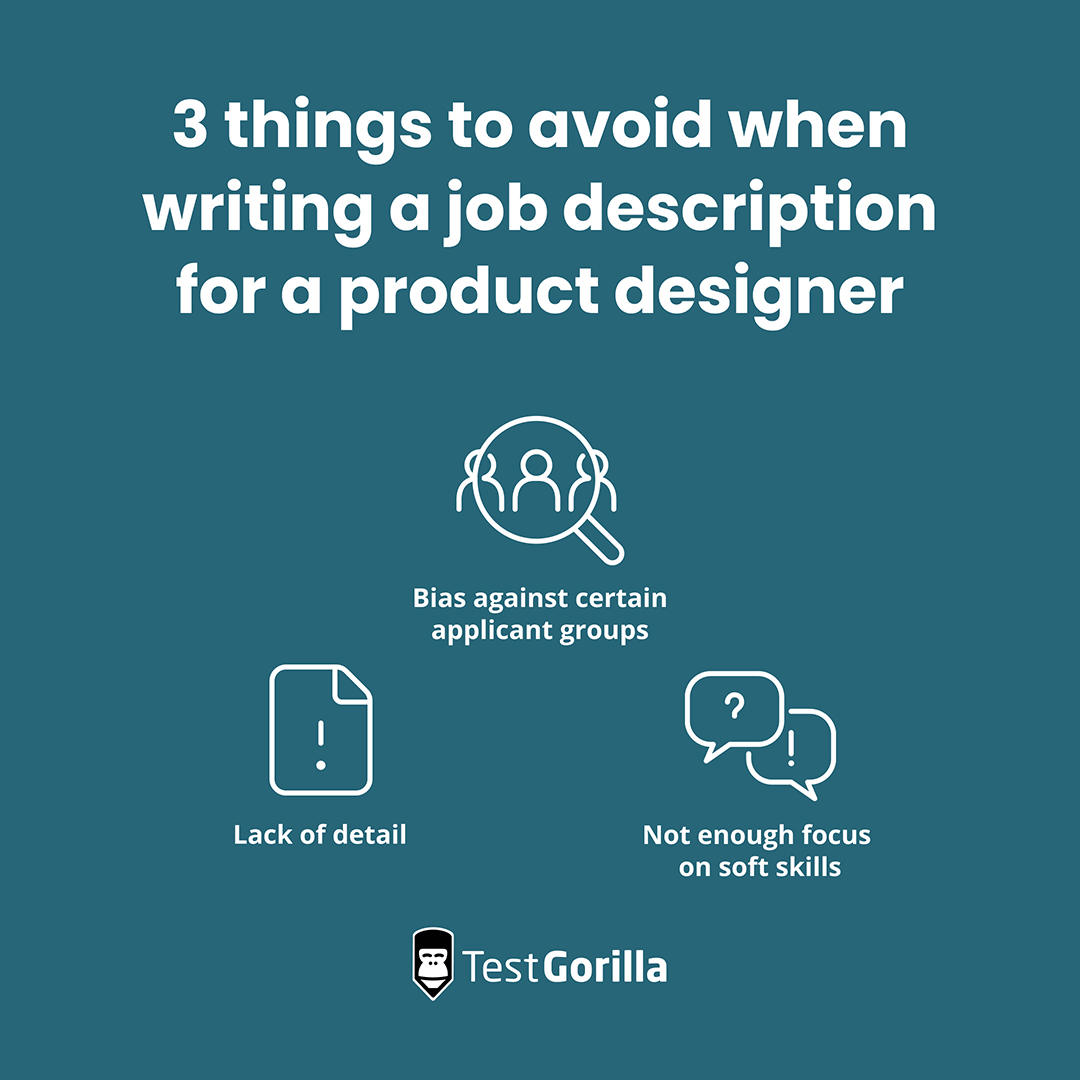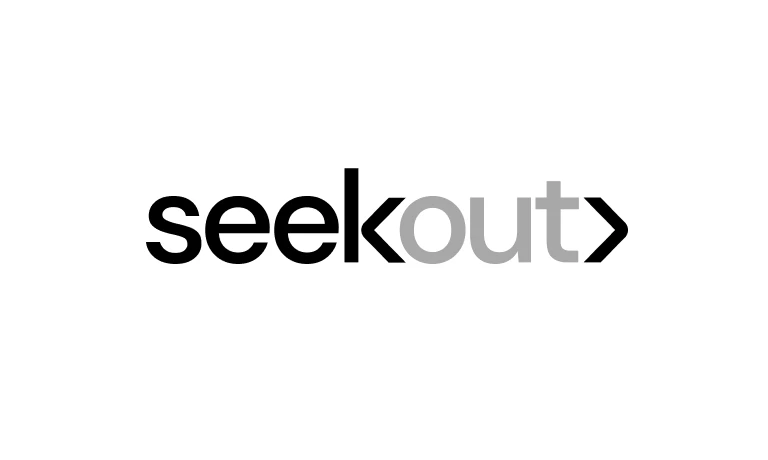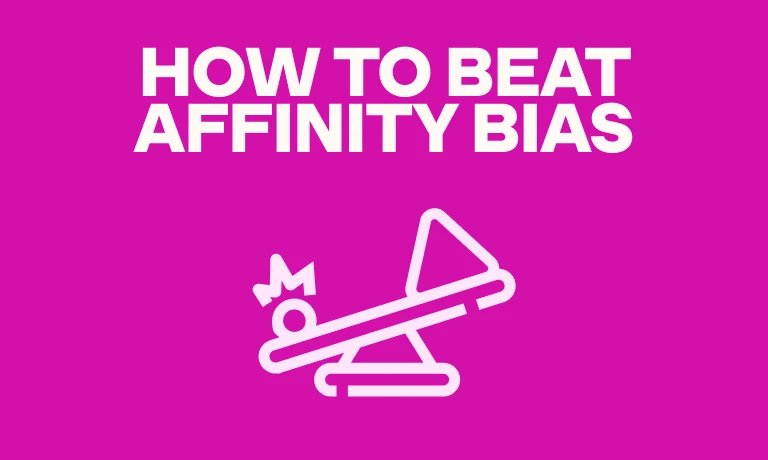Product designers use their unique skills to build user-friendly products that delight customers. However, product designers’ responsibilities can vary, making it challenging to write well-rounded job descriptions that attract top applicants.
Without a strong job description, you risk getting poor-fit applicants or making a mis-hire – which can lead to major issues with team cohesion, product quality, and company reputation.
Luckily, TestGorilla is here to help. In this guide, we break down the top skills to look for in a product designer, outline how best to prepare a job description, and even provide a product designer job description template.
Table of contents
- What is a product designer?
- Key skills to look for in a product designer
- How to write an effective product designer job description
- Product designer job description template
- 3 things to avoid when writing a job description for a product designer
- Next steps: Assessing product designer candidates
- FAQs
- Hire top product designers with TestGorilla
What is a product designer?
A product designer plays a key part in product development teams. They ensure an organization’s products are user-friendly and aligned with business goals and audience needs.
Product designers’ typical tasks include conducting user and market research, sketching web or mobile interfaces, simplifying user journeys, creating prototypes, iterating on designs, collaborating with team members, and presenting designs to stakeholders.
Key skills to look for in a product designer
The best product design candidates possess soft and hard skills that encompass:
User experience (UX) and user interface (UI) design: Applying UX/UI design skills and methods to create intuitive user journeys
Problem solving: Proactively addressing and solving user problems while managing project constraints
User research: Thoroughly understanding audience pain points, conducting user interviews, and creating user personas to inform designs
Prototyping: Creating and testing multiple product mock-ups to refine the design
Usability testing: Evaluating user journeys to ensure products are intuitive and user-friendly
Design software experience: Comfortably using design software, such as InVision and Figma
Adaptability: Improving products based on user feedback and market shifts
Communication: Clearly expressing product requirements, confidently sharing updates, and actively listening to feedback
Attention to detail: Identifying design flaws and opportunities for improvement
The best insights on HR and recruitment, delivered to your inbox.
Biweekly updates. No spam. Unsubscribe any time.
How to write an effective product designer job description
Here are the steps to writing an effective job description for product designers:
1. Define responsibilities and requirements
Product design roles have different requirements depending on factors like product type and development stage.
For example, if your product designer will primarily focus on redesigning established products, they would benefit from being well-versed in usability testing and possessing strong communication skills. On the other hand, if your new designer will mainly explore new product concepts, they’ll need solid user research and prototyping experience.
For your open role, determine what your new hire’s responsibilities will be based on the product’s nature, goals, and development stage. Also, speak with your existing product design team to gather insights into the skills and traits a designer should have to thrive at your company. For instance, perhaps they need to be excellent collaborators and be able to multitask well.
Highlight these responsibilities, skills, and capabilities in your job description to ensure you attract top applicants who will be a great fit for your team.
2. Include sufficient detail
While it can be tricky to pinpoint the product designer’s future projects, you should provide as much task-related detail as possible to minimize unsuitable applications.
For example, if you’re hiring a designer to work on your tech product’s chat function, specify this in the job description. Similarly, when stressing communication skill requirements, mention relevant stakeholders – such as coders and UI designers – that your new hire will regularly interact with.
Including this level of detail in your job description gives potential candidates a clearer understanding of the role’s requirements, enabling them to assess their suitability before applying. In turn, you ensure a more qualified pool of applicants.
3. Look at your competitors’ job descriptions
Once you’ve drafted your job description, compare it against similar roles posted by your competitors on sites like LinkedIn and Glassdoor. Check for any critical skills or requirements you may have missed. For example, you may have forgotten to mention attention to detail as a must-have for the role.
Conducting this comparison will also help you see what you can highlight in your job description that your competitors don’t. You might, for instance, notice that other companies don’t emphasize the benefits they offer. Or, perhaps they don’t disclose compensation details. Including this information in your job description can help you stand out and attract higher-quality applicants.
Product designer job description template
1. Company introduction
Write a clear, compelling –description of your company’s mission, culture, and goals. Highlight the benefits of working as a product designer within your team – like contributing toward game-changing products or collaborating with innovative individuals.
2. Product designer job brief
[Company name]
Job Title: [For example, Junior Product Designer, Product Designer, Senior Product Designer]
Reports to: [For instance, Senior Product Designer, Head of Product Design, or Chief Design Officer]
Position type: [E.g., full-time or part-time]
Location: [Remote, hybrid, or on-site]
[Salary and benefits information]
3. Product designer responsibilities
Collaborate with teams, including product management and tech, to develop our digital platforms for the [audience type – e.g., business-to-business] market
Support business targets, including customer base and engagement growth, using user-centered design principles
Produce wireframes and sketches in digital programs like Marvel to illustrate interfaces and user journeys
Develop prototypes for our [specific product type – e.g., web application] product using software such as Figma
Conduct user interviews and track usage analytics to identify UX/UI usability improvements
Use emerging design trends and user feedback to continually update existing product designs
Communicate design recommendations to the product team and reach appropriate solutions collaboratively
4. Requirements/qualifications and training required
A professional certificate or associate’s, bachelor’s, or master’s degree in product design, UX/UI design, software development, or business studies (or equivalent work experience)
2+ years experience in product design
3 things to avoid when writing a job description for a product designer
1. Bias against certain applicant groups
Avoid language in your job description that could prevent certain demographic groups from applying. For example, replace gendered phrases like “design ninja” with gender-neutral wording like “professional with excellent design abilities.”
Also, encourage applications from individuals without formal design qualifications like a bachelor’s degree. Adding phrasing like “equivalent work experience is accepted” can help with this.
2. Lack of detail
Some experienced designers may not apply if the job description doesn’t explain what tools they’ll use and what goals they’re expected to achieve in the role.
To combat this, ensure you include enough detail. For example, you might write, “Create wireframes for our upcoming mobile app products in the food and beverages market,” instead of “Create excellent designs for a mix of products.”
3. Not enough focus on soft skills
Downplaying the importance of soft skills is common in product designer job descriptions. This can deter well-rounded individuals from applying because they assume you’re looking for overly technical candidates.
Aim to combine both soft and hard skills when describing role responsibilities. For instance, write, “Use attention to detail and data analysis to determine user engagement rates.”
Next steps: Assessing product designer candidates
Once you’ve written a great job description, the next step is to sort through your applicants and identify the best candidates.
The best way to do this is by using pre-employment assessments. These offer you a straightforward, bias-free way to evaluate candidates’ skills and capabilities and are far more reliable than resume screening alone. With platforms like TestGorilla, you can even rank candidates based on their assessment scores to instantly spotlight top talent.
TestGorilla has a library of 300+ scientifically validated tests, and you can combine up to five to create bespoke assessments. We offer a catalog of product designer tests that measure various skills and aptitudes.
To evaluate your product designer candidates, you might combine the following tests for a custom assessment:
Cognitive ability tests such as our Attention to Detail (Visual) and Problem solving tests
Role-specific tests, like TestGorilla’s Product management test and UX/UI design test
Personality tests, such as the DISC or Enneagram test, which enable you to assess candidates’ behavioral traits
Situational judgment tests, including the Communication (Intermediate) test
Software tests that evaluate proficiency in tools like Figma, SketchUp Pro, Adobe Illustrator, and others
FAQs
What does a product designer do daily?
On a typical day, a product designer may update their team on their task status, evaluate user feedback and analytics, improve sketches and prototype components, collaborate with team members, and develop new design ideas.
Is a product designer a UX designer?
A product designer has some responsibilities in common with a UX designer, but the two are different roles. Product design can include UX design tasks, such as wireframing and usability testing. However, a product designer is additionally responsible for how the broader product functionality aligns with business objectives and customer needs.
Hire top product designers with TestGorilla
A product designer job description that’s tailored to your role’s unique responsibilities helps you attract and identify top-quality candidates. By following the tips and template outlined in this guide, you’re well-equipped to create your own product designer job description and kickstart the hiring process.
Your next step will be screening applicants to identify the best candidates. The most effective way to do this is through comprehensive, unbiased assessments. TestGorilla’s extensive test library has all the job-specific skills, personality, and cognitive ability tests you need to evaluate your candidates and select the best person for your open role.
Get started with TestGorilla today by taking a product tour or signing up for a free account.
You've scrolled this far
Why not try TestGorilla for free, and see what happens when you put skills first.



















